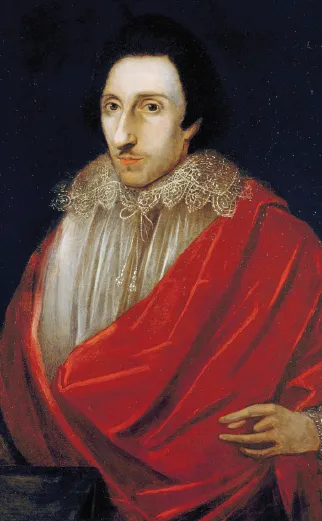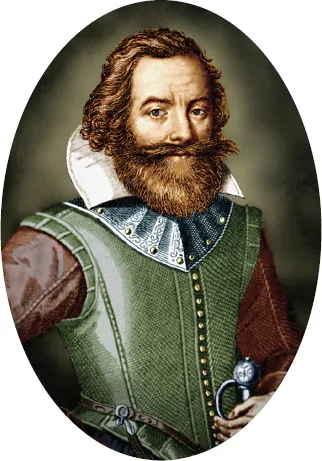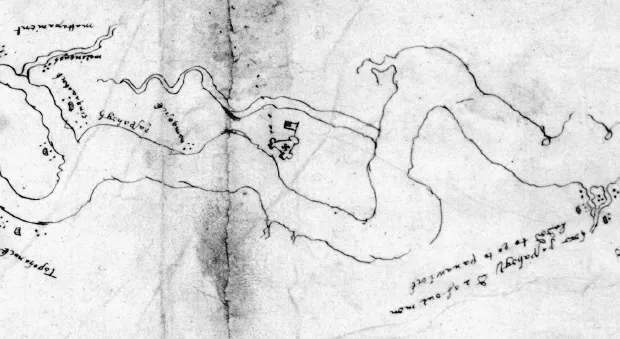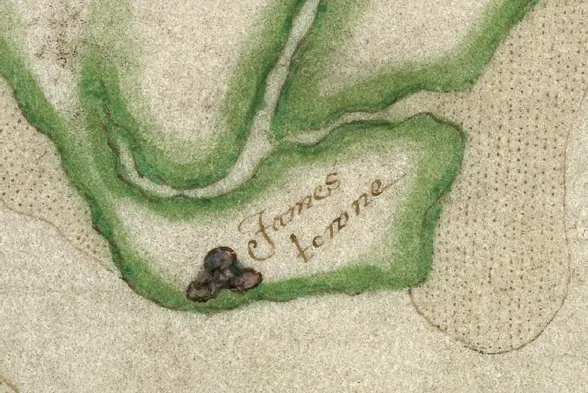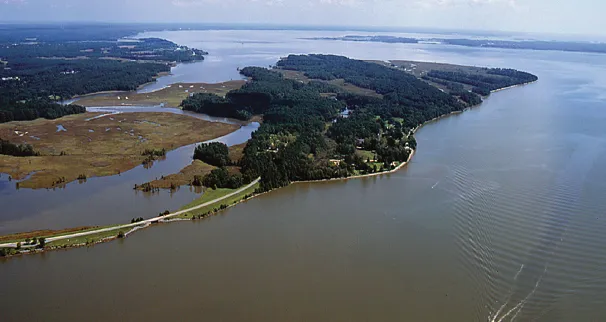![]()
PART I
BURIED TRUTH
![]()
ONE
REIMAGINING JAMESTOWN
The soil was good and fruitful, with excellent good timber. There are also great store of vines in bigness of a man’s thigh, running up to the tops of the trees, in great abundance … many squirrels, conies, blackbirds with crimson wings and divers other fowls and birds of divers and sundry colors of crimson, watchet, yellow, green, murrey and of divers other hues naturally without any art using.1
The exuberant eyewitness description given above of the Virginia wonderland came from the pen of George Percy, one of the first Jamestown settlers, who was to become governor of the colony almost by default when the dreamland turned into a nightmare two and one-half years later. Percy’s account of the voyage to the New World is the most complete of the firsthand descriptions of the founding of Jamestown and the fate of the colonists during the first spring and summer in Virginia.
Eyewitness testimonies carry great weight in any search for the truth. A reading of the documents pertaining to early Jamestown is essential if we are to discover its buried secrets. But documents must be read carefully: the testimony even of eyewitnesses must be scrutinized, keeping in mind that the authors were not immune to dreams of gold and glory that might distort their accounts. It is important to ask, for instance, how much of the fruitful abundance Percy describes in his first sighting might have been merely an expression of the hopes of a new settler rather than reality.
An examination of the documents contemporary with Jamestown’s founding offers hints of the precise location, configuration, and artifacts of James Fort. In all, only a half dozen first-hand descriptions and three maps survive from the earliest years of the colony to guide an archaeologist’s shovels and trowels. Here are the salient facts about the writers of these documents:
George Percy, highest-ranking original settler and lieutenant governor during the “starving time” winter of 1609–10. By Herbert Luther Smith. (Virginia Historical Society, Richmond)
Bottom: Captain John Smith, by Simon de Passe. (Courtesy of the Library of Virginia)
John Smith: Arrived in Jamestown 1607. Yeoman farmer’s son, mariner, and soldier, often at odds with his less-experienced and higher-born colleagues. From 1608 to 1631 he published varying accounts of his twenty-nine months in Virginia, as well as heavily edited reports written by other settlers who stayed on. His sometimes-inconsistent accounts sought to justify his actions at Jamestown as well as promote colonization.
Gabriel Archer: Arrived in Jamestown 1607. Mariner and explorer, trained in the law. As recording secretary for the Virginia governing council, he described the earliest days of Jamestown in what appear to be official reports sent back to the Company in England. A devoted enemy of John Smith, he died during the “starving time” of 1609–10.
George Percy: Arrived in Jamestown 1607. Son of the Earl of Northumberland, Percy was one of the highest-ranked of the colonists on the social scale. He served as stand-in governor during the “starving time” and was reappointed in 1611. Percy wrote an account of the 1606–7 voyage from England and a refutation of Smith’s 1624 Generall Historie, which had put much of the blame for the “starving time” on Percy’s shoulders.
Ralph Hamor: Arrived in Jamestown 1610. A stockholder in the Virginia Company and, later, in the 1620s, a member of the governor’s council, he published an apparent promotional report in 1615 that described a flourishing Jamestown in 1611–14 and urged further investment and emigration.
William Strachey: Arrived in Jamestown 1610. Secretary of the colony. His letter of 1610 includes an account of the colony as he saw it in May–July 1610 and a summary of earlier events, which Percy apparently dictated to him. The most polished of the early reporters, he wrote the most exact description of James Fort, but his reliance on Percy casts some doubt on the accuracy of his account of Jamestown’s first three years.
“The Ancient Planters of Virginia”: Writing in the spring of 1623, these surviving original settlers thought the Crown should know about the mishandling of the colony under the leadership of the Virginia Company treasurer, Sir Thomas Smythe. Although cast to shed ill light on Smythe, the account by the “Ancient Planters” includes details about Jamestown houses and hardships during the early years.
Don Pedro de Zúñiga: The Zúñiga map of Virginia was delivered to King Philip III of Spain in 1608 by his ambassador to England, Don Pedro de Zúñiga. This is believed by some to be a tracing of an early map by John Smith. The map includes a minuscule sketch of James Fort. Zúñiga repeatedly urged King Philip to wipe out the colony.
Johannes Vingboons: The Vingboons chart is a Dutch navigational chart showing structures on Jamestown Island as well as downriver forts, all in an area labeled “New Nederland.”
THE FORT
Known as the Zúñiga map (1608), this is one of three known seventeenth-century renderings of James Fort. (Ministerio de Educación y Cultura de España, Archivo General de Simancas, MPD,19,163)
In May 1607, Virginia looked like the Garden of Eden to Percy and probably to the 104 English “gentlemen, artisans, laborers and servant boys” seeking a place to settle in the name of King James I, and, more important, a place to reap profit for their investors, the Virginia Company of London. At this point, Virginia appeared to be what they expected: the ideal place to plant a permanent colony of English people, to find gold and a route to the rich Orient, and to convert the natives to Christianity. The Virginia Company officials had instructed the adventurers to settle at least one hundred miles from the ocean, in a place where a major river narrowed, offering defensive positions on either side of any attacking ship—which would surely be Spanish, avenging past English privateering raids. As an alternative, the colonists were advised to settle “some Island that is strong by nature.”2 Led by Christopher Newport and Edward Maria Wingfield, and following their instructions, the three ships entered the largest river of the Chesapeake, which they named after their king. The party then sailed as far as sixty-five miles northwest looking for that defensible narrow stretch of river. Reaching the Appomattox River without having found an uninhabited place with the right requirements, the colonists turned back toward the bay. On May 13, the group decided to settle a point of land that was actually an island at very high tide. Why there? Percy explained that here the channel was so close to the shore that ships could be tied to the trees.3 Other considerations made Jamestown Island the settlement site of choice. Again the Virginia Company’s instructions came into play: the colonists were not to upset the Virginia Indians, especially by settling on land the natives already occupied. Jamestown Island was vacant. Although the island was a mere thirty-five miles from the open ocean, from which the Spanish could launch an attack, it still qualified as a naturally defensible place, with its narrow neck of land to guard against assault from the mainland Indians and its naturally hidden location in a sharp bend in the river. The several ridges at Jamestown Island provided ideal sites for a fort, particularly the third ridge from the west, the highest point of land on the north shore of the river bend. It is also possible that, although the Indians did not then occupy the land, they had been there in the not-too-distant past. By 1607 their cleared land might have evolved into a fair-sized grove of straight, tall, second-growth hardwood trees, ideal for building timber palisades and blockhouses.4 Captain John Smith deemed Jamestown Island “a very fit place for the erecting of a great cittie.”5
Tindall map of Virginia, 1608, showing original map of James Fort (“James towne”). (© The British Library Board)
The next day the colonists—all men—filed ashore, onto what the English adventurers decided to call Jamestown Island on the north shore of the James River.6 That first landing day, Smith reports,
now falleth every man to work… cut down trees … pitch tents … some provide clapboard to relade the ships … some make gardens, some nets … the council contrive [design] the fort… no exercise at arms or fortifications but the boughs of trees cast together in the form of a halfmoon … by Captain Kendall.7
Jamestown Island from the west.
The island was a busy place, with the men doing exactly what they needed to do for survival: clearing the land, establishing shelter, preparing to live off their own gardens and the native fish, and fortifying themselves despite Company instructions not to upset the Indians by doing so. Like Smith, chronicler George Percy tells of throwing up a brush fort. Percy also writes of establishing a military guard “to watch and ward.”8 This exercise was wisely done. The settlers soon were challenged by the Paspahegh Indians from the nearest village.
Arriving with a hundred men in arms—a message that the English soldiers were essentially outnumbered and surrounded—the Indian leader “made signs that he would give us as much land as we would desire.”9 Of course, the settlers already believed they had ownership by the English king’s patent of the whole of continental North America. In any case, they must have rapidly accepted the offer, surely one that meant no more than the 1,600-acre Jamestown Island. But the deal seemed to go sour when one of the Indians grabbed a soldier’s hatchet, prompting a scuffle in which a native was struck on the arm. The chief and his warriors left in anger.
The Indians seemed to be a forgiving lot, for two days later forty appeared at the Jamestown “quarter” with a deer. In addition, they offered to stay in the “fort” all night. Sensing ambush, the English denied the overnight and proceeded to flaunt their own military prowess. “One of our gentlemen” put on a demonstration to prove English weapons superior to the Indian arrows. He first set up a leather “target” (hand shield) for Indian target practice. An arrow penetrated a foot into the leather. Next a “steel target went up which shattered his arrow all to pieces.”10 This set the stage for open warfare one week later.
This seventeenth-century Dutch image of soldiers and their tents on a river in the Low Countries is reminiscent of John Smith’s 1607 description of the colonists’ first day at Jamestown Island. (River Landscape with a Tent, Philips Wouverman, copy credited to Verlag Hanfstaengl, Munich, in Walter Bernt collection, Fine Arts Library, Harvard University)
On May 27 Captain Gabriel Archer described the first battle, “a very furious assault to our fort” by some two hundred warriors who “came up allmost into the fort, shott through the tentes.” The battle “endured hott about an hower,” hurting “11 men [Smith reported 17 casualties] (whereof one dyed) and killed a Boy…. We killed divers of them . . . how many hurt we know not. . . . Foure of the Counsell that stood in front were hurt in mayntayning the Forte, and our President, Master Wynckfield (who shewed himself a valiant Gentleman) had one shott clean through his beard.”11 Wingfield seems to have escaped harm literally by a whisker, but the other four councilors in town, John Martin, John Ratcliffe, George Kendall, and Bartholomew Gosnold, were apparently not so lucky. However, the seriousness of their wounds drew no further comment from Archer. Wingfield, who presumably now knew the men would need more than their beards, brush, and canvas to stay alive, ordered that the settlement be immediately and this time seriously fortified. The camp was to be enclosed with palisades (logs set side by side in the ground)—the men “labored pallozadoing our fort”—and the cannons were mounted.12 These activities marked the beginning of James Fort. In only nineteen days, the enclosure stood complete. According to Percy, on June 15 “we had built and finished our fort, which was triangle-wise, having three bulwarks at every corner like a half-moon, and four or five pieces of artillery mounted in them.”13
Building the fort was no easy tas...

